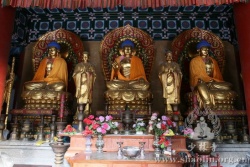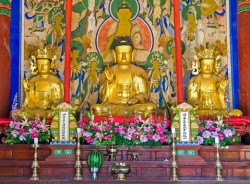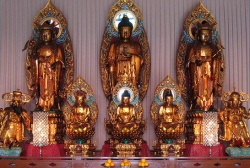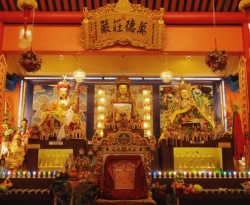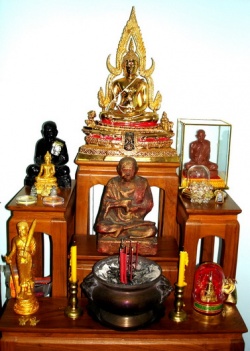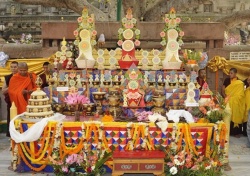How to Set Up a Buddhist Shrine
Adapted from How to Setup an Altar or Shrine by Ven. Tenzin Yignyen of Namgyal Monastery.
Why Have an Altar *
A proper altar holds images or representations of the Buddha's enlightened body, speech and mind which serves as reminders of the goal of Buddhist practice -- to develop these qualities in oneself so as to be able to fully benefit all sentient beings. The reason for setting up an altar is not for fame, for showing off wealth, or to increase pride, but rather it is to reduce one's mental afflictions and to seek the ability to help all sentient beings.
Where to Place the Altar*/Shrine
The best place . . . is in a separate shrine room, but if you live in a small place and cannot set aside a separate room for worship, any room can be used. The size of the altar is not important, but it should be in a clean and respectful place, higher than the level of your head as you sit facing it.
If it is in your bedroom, the altar should be placed near the head of your bed, never at the foot, and it should be higher than the bed. The altar should be either on a separate shelf or on a table set aside for this purpose that does not double as a coffee table or night stand.
The Objects and What They Represent
A proper Buddhist altar holds symbols of enlightened body, speech and mind, traditionally represented by displaying a statue or picture of Buddha Shakyamuni, a scripture, and a stupa [[[Tibetan]]: chorten].
At the very least, the altar should hold an image of Buddha Shakyamuni, the founder and source of the teachings in our time.
Regarding the placement of the images, it is important that Shakyamuni Buddha be the central figure. Other images are not requisite, but if you have them, place them around the central figure in this order: root lamas, yidams (highest yoga tantra deities, yoga tantra deities, performance tantra deities, then action tantra deities), dakinis, and finally protector deities. The order of the arrangement is never by the quality of the material or the artistry. Often it is better to have only a few images, as too many can be distracting.
The scripture representing the speech of the Buddha does not need to be written in Tibetan or Sanskrit, but can be in any language. It can be the Heart Sutra if you wish to represent all the teachings of the Buddha, or it can be a special scripture related to your practice. If the altar consists of three or more levels, the scripture should be placed highest on the altar, above the Buddha statue. If the altar is on one level, the order should be, from left to right: scripture, Buddha, stupa.
The mind of the Buddha is traditionally represented by a stupa of enlightenment, but you need not go out and buy a costly silver or gold one. A photograph or a clay model is perfectly acceptable. The stupa [Tib.: chorten] should be placed to the right of the Buddha image, or below the Buddha if the altar consists of several levels.
The objects on the altar also represent the Three Jewels of Refuge. If there is only a statue of Buddha Shakyamuni, think that it represents all Three Jewels. If there is also a scripture and a stupa, think that the stupa represents the Buddha Jewel, the scripture represents the Dharma Jewel, and the image of the Buddha represents the Sangha Jewel.
It is important to keep in mind that the objects on the altar serve as a means for directing one's mind to the Buddha and the Buddha's enlightened qualities, which we aspire to emulate for others' benefit. In maintaining an altar one is trying to cultivate the qualities of the Buddha -- his enlightened body, his enlightened speech and his enlightened mind.
By remembering these qualities and aspiring to develop them, one reduces the negative qualities of attachment, hatred and ignorance, and increases positive qualities like faith, respect, devotion and rejoicing.
Making Offerings
There is no limitation to what can be offered, and there are many levels of offering. In general, one can offer any pleasing object, particularly objects pleasing to the five senses -- form, sound, smell, taste, and touch.
In the Tibetan Buddhist tradition it is customary to offer seven bowls of water which represent the seven limbs of prayer -- prostrating, offering, confession, rejoicing in the good qualities of oneself and others, requesting the Buddhas to remain in this world, beseeching them to teach others, and dedicating the merits.
Flowers, candles or butter lamps, and incense are also commonly offered. It is customary to offer a part of every meal on the altar before eating and a portion of tea before drinking.
The things that should be offered should be clean, new and pleasing. . . . only the best part, fresh, and clean -- never old, leftover, or spoiled food.
It is best to offer things that you already have or can obtain without difficulty. Don't think that you have to deceive others in order to get offering materials -- they should not come from stealing, cheating or hurting others in any way. Rather, they should be honestly obtained. In fact, it is better not to offer things that were obtained in even a slightly negative way.
As you make offerings, think that what you are offering is in nature your own good qualities and your practice, although it appears in the form of external offering objects. These external offerings should not be imagined as limited to the actual objects on the altar, but should be seen as vast in number, as extensive as space.
Offer food with the wish that all beings be relieved of hunger, and offer water with the wish that all beings be relieved of thirst.
It is important to think that the deities accept the offerings, enjoy them and are pleased. Think that by making these offerings all beings are purified of their negative qualities and their thirst for knowledge of the ultimate nature of reality is satisfied.
The purpose of making offerings is to accumulate merit and in particular to develop and increase the mind of generosity and to reduce stinginess and miserliness. By making offerings you also create the causes for the future results of becoming wealthy and becoming naturally and spontaneously generous.
Placing the Offerings on the Altar
If you have the space, place the offerings a little lower than the objects of refuge on your altar. When you awaken in the morning, it is customary to wash at least your face before approaching the altar to offer prostrations and then offerings -- this is a sign of respect for the objects represented there. One is making offerings as if one is accepting a dignitary or a great being into one's home, and it is important to be gracious and respectful.
To offer water on your altar, you should have a minimum of seven bowls. Start with fresh water every day. The bowls should be clean. Pour a little water into each bowl before placing it on the altar. Place the bowls in a straight line, close together but not touching. The distance between the bowls is traditionally measured by the width of a grain of wheat. The bowls should then be filled up to the space of a grain's width from the top -- neither too little nor too much. Pour water like the shape of a wheat grain -- in a thin stream at first, then gradually more, then tapering off at the end.
Try not to breathe on the offerings. If you have a butter lamp, you can place it on your altar between the third and fourth water bowls. Lamps or candles symbolize wisdom, eliminating the darkness of ignorance. In Tibetan monasteries hundreds of lamps are lit as offerings. There is really no limit to the quantity of either water bowls or lamps.
Blessing The Offerings
After pouring the water, lighting the candles and offering incenses the offerings by dipping a piece of kusha grass (or a tree twig) into the water, reciting three times OM AH HUM (seed syllables of the Buddha's body, speech, and mind), and then sprinkling the offerings with water. Visualize that the offerings are blessed.
Dedication
Whether external offerings become pure or not, or whether they become a cause for good rebirth in the next life, a cause to achieve liberation, or a cause to achieve enlightenment to benefit all beings depends on one's motivation and dedication. Dedication is crucial.
It will not exhaust or limit one's store of merit but will multiply and increase it. It is excellent to dedicate the merit of making offerings to the elimination of suffering and its causes from all beings, to their achievement of lasting happiness, and to world peace.
Removing the Offerings
At the end of the day, before or at sunset, empty the bowls one by one, dry them with a clean cloth and stack them upside down or put them away. Never leave empty bowls right side up on the altar. The water is not simply thrown away but offered to the plants in your house or in the garden.
Food and flowers should also be put in a clean place outside where birds and animals can eat them. Bowls of fruit can be left on the altar for a few days and can then be eaten when they come down -- there is no need to put them outside.
- Some people object to the use of the English word altar in reference to the surface upon which we keep objects symbolizing the 3 Jewels. The word altar derives directly from the meaning high place with the connotation of sacrifice and proximity to the gods.
It goes against fundamental Buddhist teachings to make offerings to beings with the idea of appeasing or bribing them. Read on to see why it is better to think of this table or set of shelves as a shrine - with the idea of remembrance- rather than an altar.
The Meaning of the 8 Offerings
edited from a talk by Khenpo Konchog Gyaltsen Rinpoche (5/1/1993)
". . . enlightened beings do not want or need these things. We make offerings for our own benefit, to accumulate great merit and wisdom.
Enlightenment, Buddhahood, is achieved through the two great qualities - accumulation and purification. As you know, the Buddha has limitless qualities, which were gained through the great accumulations and purifications. Our offerings are a simple way to accumulate both merit and wisdom.
1. WATER TO CLEANSE THE MOUTH OR FACE - Auspiciousness
It signifies auspiciousness or all the positive causes and conditions which bring positive effects. So, make an offering of water which is clean, fresh, cool, smooth, light, delicious, comfortable to the throat and stomach - these qualities are the qualities of auspiciousness. When you drink that kind of water, it is healthy; if you take a shower with it is healthy. While you make this kind of water offering to the enlightened beings, visualize an ocean of water.
Then we dedicate this water to become a cause for all sentient beings to also collect positive causes and conditions. So this is the first water offering - to cleanse the mouth or face.
2. WATER TO WASH THE FEET - Purification
This is clear water mixed with incense or sandalwood which is made as an offering to all enlightened beings' feet. The symbolic meaning is purification. By cleansing the feet of the enlightened beings, we cleanse all our own negative karma and obscurations. By making offerings to clean the enlightened beings feet, we are really cleaning the "feet" of our own mind.
With respect, devotion and confidence, we offer an ocean of this kind of water to all enlightened beings to purify all the temporary obscurations of ourselves and all sentient beings. Obscurations are called "temporary" because they can be purified. If they were permanent, we could not purify them even if we make an effort. So meditate on this when you make these offerings.
All the different types of obscurations -- gross, subtle, negative karma, afflictive emotions, and obscurations to enlightenment -- all these different types of obscurations become fully purified.
3. FLOWERS - Generosity
Next is offering of ... the flower of the beauty of enlightenment. It signifies the practice of generosity and opens the heart. A flower is very beautiful; so you naturally want to keep it.
But when you offer it to others, there is some special feeling in the mind. With that connection, make the offering and practice freedom from stinginess. Milarepa said there is no special practice of generosity if one is free from stinginess. Meditate on that by offering flowers, which signifies the practice of generosity.
May all sentient beings achieve the freedom and endowment of a precious human life. Flowers are offered to the head of the enlightened beings, for them to wear on the crown of the head. Within the practice of generosity, we immediately think of giving wealth, giving fearlessness, giving wisdom -- there are many different types of generosity.
Usually when we say generosity, we immediately think of giving wealth, but it is not only that. For example, giving fearlessness means giving life. If someone is afraid for their life, like drowning in water, and if you give them safety from the water, this is called giving fearlessness, giving freedom from danger to life.
Giving wisdom is very special generosity. When we give teaching to one who has no wisdom -- does not know what samsara is, what enlightenment is, or what the cause of suffering is -- that is such a great gift. To help them understand "Oh, that is samsara, that is enlightenment." Such a great gift! So, offering a flower symbolizes generosity.
4. INCENSE - Discipline, Moral Ethics
Moral discipline is one of the most important practices. In the West, maybe discipline and morality are a little bit different. What I mean here is that when we have good discipline, there is morality. Discipline is in the teaching of the Dharma. For instance, it says, "do this, this, this. Sit like this, meditate like this." It is taught like discipline. So when we do that, it is good moral ethics; when we cannot do these things that are taught to be done, then there is no morality, no ethics.
In Sanskrit, this is called shila ... . means coolness, freshness. When we have good discipline, it cools the mind free from suffering. When we stay in that position well, it relaxes the mind and frees it from agitation. All these disciplines are part of the process of progressing in our meditation practice. Unless these disciplines and moral ethics are there, it is not possible to achieve enlightenment.
Therefore, Buddha gave these three teachings -- moral ethics, samadhi and wisdom -- called the Three Trainings. These Three Trainings are very important. Wisdom or special insight comes from samadhi, [[[meditation]]] the stability and strength of the mind. That kind of strength in the mind is based on discipline and morality. So they are all related to each other, are connected to each other and depend on each other.
Therefore, moral ethics is a very important aspect of path. Incenseh is the nature of morality, makes offerings to the nose of the enlightened beings. The enlightened beings are not attached to smell, but to our purity. All people respect those who have kept moral ethics well. It doesn't matter who they are, they get respect because they are trustworthy and dependable. That kind of person gives a good smell, good odor, and people are attracted to that. not only people, but the qualities of enlightened beings are also attracted by that morality. It is their foundation/basis, like the ground which grows ... the "crops" of ... enlightened qualities.
5. LIGHT - Patience
Light . . . signifies the stability and clarity of patience, the beauty which dispels all ignorance. The light offering is made to the eyes of all the enlightened beings, who see clearly without mistake. Some people feel patience is showing weakness or pessimism. But, actually, patience shows the strength and clarity of mind, which are based on wisdom and compassion.
Without proper wisdom and compassion, one cannot practice patience. So light shows that the strength of the mind, the clear, stable nature of the mind, achieved through the practice of patience. Because the mind is not disturbed by other forces, it has such great qualities: clarity knows what is to be done, which is necessary, which is not necessary. That dispels ignorance.
Patience can be practiced in all different forms, different ways, not just when people are faced with anger. For example, there is patience in Dharma practice and study. First, this is based on wisdom, so we should have such wisdom to really know how Dharma is, what quality it has, the depth and vastness of Dharma, and how we can achieve these qualities. Seeing those great qualities, then we need patience to study and practice. When we have that, there is a mind of clarity, of stability.
On the other hand we should not be patient with our afflictive emotions. When we have anger, desire, jealousy, pride, don't practice patience with these! This is the wrong way to practice patience. Even if it is hard or painful, these are subjects to get rid of or purify; they don't do any good thing. Without sacrificing something, there is no chance that we will have peace and happiness. So no matter what kind of pain we face, what difficult circumstances we face, we have to go thru it. Even if we have to sacrifice this life, it is worthwhile to sacrifice.
A lot of people commit suicide to get rid of all these afflictive emotions. They are overpowered by the afflictive emotions and they kill themselves. That is the wrong way to sacrifice this life. We have to sacrifice this life the other way around. Buddha said that if we have to lose our life to keep the moral discipline, it just finishes this life, but next lives will be higher and higher, better and better. But if we do it the other way around and sacrifice this life for the afflictive emotions, then we will go worse and worse.
In Shantideva's text it is said that we should not commit suicide or give this body without much purpose. Rather, we should cherish this precious human life. An explanation is given. When a medicinal tree is very small plant, it has to be protected in order to grow into a huge tree. If you pick it up when it is small, it will benefit only a few and then it is finished. But if you protect it well with many fences, it will grow into a huge tree that will bring fruits, flowers, roots, leaves, branches for the benefit of many, many sentient beings.
Similarly we have a fragile mind at this time. We must protect this precious human life with all these antidotes, fences, and let it grow big. Then we can benefit many sentient beings. By the practice of patience, all the 112 major and minor marks of a Buddha will come. Of course, we should not expect it, but the result of patience is a healthy, good body, to which all people are attracted, which is respected and admired. All this comes from the practice of patience.
6. FRAGRANCE - Perseverance
. . . the fragrance of saffron or sandalwood. -- all the different types of perfume . . . signifies perseverance or joyous effort. Through that one quality, one develops all the qualities of enlightenment. Without perseverance, without joyous effort, nothing can be achieved. Even in samsara, we have to work so hard to achieve anything. A lot of people sacrifice a lot of things just for samsaric achievement. You sacrifice your life for your work; if you die, what will you do with your wealth? So now, see the other side -- Dharma study and practice. When we could make such a great effort to study, practice Dharma, we have to sacrifice some little thing.
It is said in Shantideva's text that studying Dharma is the cause to freedom from suffering. To achieve ultimate enlightenment, ultimate happiness, why can't we do that? Others in samsara, . . . even sacrifice their life for their achievements, but that becomes a cause only for suffering.
As flowers were offered to the eyes of enlightenment, perfumes are offered to the Buddha's mind because perseverance is the heart of enlightenment. Perfect generosity, moral ethics, patience, samadhi, wisdom -these all depend on perseverance. Without joyous effort none of these can be accomplished, so it is the heart, the essence. Meditate that by this offering, may all sentient beings progress in their attainment of the qualities of enlightenment.
7. DELICIOUS FOOD - Samadhi
. . . food which has a lot of different tastes. The delicious, excellent quality of food signifies . . . nectar or ambrosia to feed the mind. This is an offering to the tongue of the enlightened beings, the Buddhas and Bodhisattvas. Samadhi is also the source of all the siddhis like clairvoyance.
There are two different types of clairvoyance -- ordinary clairvoyance is usually from other lifetimes. The other type is special insight clairvoyance, which we achieve this lifetime through meditation practice. Flying in the sky, different types of miraculous power, these can all be achieved through samadhi, the virtuous one-pointed mind.
The very stable mind, one-pointed, clear, calm, peaceful mind of samadhi becomes a basis to achieve all the enlightenment qualities. Food symbolizes samadhi because eating food maintains this body, and samadhi is a kind of food that maintains the mind as well as the physical body.
When you achieve any kind of samadhi, it is the fruition of the effort you made before, and it can also become a path to get higher fruition. Generally, when we eat nutritious healthy food, it makes our health better. ... the nutritious food of samadhi, it keeps the health of the mind. It makes the mind healthy, clear, calm and peaceful. By making this offering of delicious food, may all sentient beings have the health which results from the samadhi food. May all sentient beings have the samadhi nature, quality.
8. MUSICAL INSTRUMENTS - Wisdom
There are different types of instruments -- cymbals, bells, guitars, lutes -- all of these are offered. Their nature is wisdom, which makes an offering to the ears of the Buddhas and Bodhisattvas and all the enlightened beings.
Sound represents wisdom because wisdom is a special power of the mind which penetrates phenomena. Compassion is achieved through great wisdom; interdependence of all phenomena is realized through great wisdom. of course all phenomena have the nature of interdependence, causes and conditions, but sound is especially easy to understand. If you play a guitar, what does the sound depend on? It does not come just from the piece of wood, the string, not from the finger.
So where does it come from? It comes from all these things, none alone is sufficient to produce the sound. That nature is called illusion. We can hear the Sound, but it has no independent existence. So we should see all sound having that nature. It just comes and goes like an echo. That realization is wisdom, and through that realization we can attain supra-mundane quality.
May the wisdom, that quality of the supra-mundane, arise within the minds of all sentient beings and free them from all confusion and ignorance. May they achieve enlightenment.
Questions & Answers
Q. Should the bowls be emptied every evening?
A. Yes, when you empty them, you should meditate on impermanence. Now all the enlightened beings are fully satisfied. Dedicate the merit accumulation of making these offerings to all sentient beings. May all those beings also become Buddhas and Bodhisattvas, free from confusion and suffering.
Q. Do you have to have actual flowers, or can I use rice or water?
A. Buddha said that there are so many different levels of meditation practice -- from 100% to 1%. So all this we can do depending on the individual practitioner. But even the 1% . . . -- it's better than nothing.
When we make offering by filling all the bowls with rice, it is wonderful. The Buddha said that even if you take one piece of flower and throw it in the air while focusing on the Buddha, that will become a cause for freedom from samsara.
Q. Some people make it very elaborate and elegant, expensive looking; others have simple white bowls with water.
A. No matter what, you have to have a pure motive. This is very important. With pure motivation, any offering you make is good. Expensive is great because you sacrifice a lot of things for that offering. but if you do not have pure motivation, like doing it to show wealth, then maybe it's not so pure.
We work this entire life, so for us these things mean so much. When we make an offering of them to the enlightened beings, it has meaning for us. We sacrifice that part of our life. In this way, offering becomes a special meditation practice."



